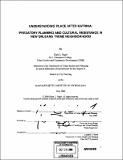| dc.contributor.advisor | Xavier de Souza Briggs. | en_US |
| dc.contributor.author | Nagel, Kiara L | en_US |
| dc.contributor.other | Massachusetts Institute of Technology. Dept. of Urban Studies and Planning. | en_US |
| dc.coverage.spatial | n-us-la | en_US |
| dc.date.accessioned | 2007-07-18T13:00:07Z | |
| dc.date.available | 2007-07-18T13:00:07Z | |
| dc.date.copyright | 2006 | en_US |
| dc.date.issued | 2006 | en_US |
| dc.identifier.uri | http://hdl.handle.net/1721.1/37867 | |
| dc.description | Thesis (M.C.P.)--Massachusetts Institute of Technology, Dept. of Urban Studies and Planning, 2006. | en_US |
| dc.description | Includes bibliographical references (p. 96-99). | en_US |
| dc.description.abstract | The fate of New Orleans in the aftermath of Hurricane Katrina is uncertain. The rebuilding of the Gulf Coast presents the nation with the most massive redevelopment project in a single location ever. Reminiscent of the Urban Renewal changes between the late 1940s and early 1970s. Urban Renewal redevelopment projects were touted as being beneficial to the city by providing easier access to downtown and the construction of new housing. However, hindsight and scholarship coupled with the experience of thousands of residents, has taught us that the lasting effects of urban renewal included displacement of residents, disruption of community ties, and extensive psychological traumas associated with these shocks. In New Orleans, for example, the heart of the black business district along Claiborne Avenue in the Treme neighborhood, one of the oldest African American neighborhoods in the country, was cleared for the construction of the I-10 Expressway. The Storyville section, arguably the birthplace of jazz, was broken apart to make room for the Iberville Housing Projects. The fight against Armstrong Park continued for several decades, eventually ending in defeat with the displacement of over 400 families. | en_US |
| dc.description.abstract | (cont.) Now, Hurricane Katrina has uprooted hundreds of low-income residents, many of whom were victims of Urban Renewal, others of whom are the children of those victims, raised on their stories. The neighborhood's history of cultural resistance is rooted in the public commons, once again under threat in the redevelopment process. New Orleans residents and organizers are scrambling for a foothold in the process despite widespread trauma and limited capacity. Planners have an opportunity to rethink their role in the context of synergistic damage accumulation, widespread trauma, and a new level of predatory planning. The time ripe to examine the lessons of the past and explore the implications they may have for the current rebuilding process in post-Katrina New Orleans. | en_US |
| dc.description.statementofresponsibility | by Kiara L. Nagel. | en_US |
| dc.format.extent | 99 p. | en_US |
| dc.language.iso | eng | en_US |
| dc.publisher | Massachusetts Institute of Technology | en_US |
| dc.rights | M.I.T. theses are protected by copyright. They may be viewed from this source for any purpose, but reproduction or distribution in any format is prohibited without written permission. See provided URL for inquiries about permission. | en_US |
| dc.rights.uri | http://dspace.mit.edu/handle/1721.1/7582 | |
| dc.subject | Urban Studies and Planning. | en_US |
| dc.title | Understanding place after Katrina : predatory planning and cultural resistance in New Orleans Tremé Neighborhood | en_US |
| dc.type | Thesis | en_US |
| dc.description.degree | M.C.P. | en_US |
| dc.contributor.department | Massachusetts Institute of Technology. Department of Urban Studies and Planning | |
| dc.identifier.oclc | 124064761 | en_US |

